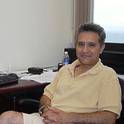
Article
On The Detection Of Ionizing Radiation Arising From Star-Forming Galaxies At Redshift z ~ 3-4 : Looking For Analogs Of "Stellar Reionizers"
The Astrophysical Journal
(2011)
Abstract
We use the spatially-resolved, multi-band photometry in the GOODS South field acquired by the CANDELS project to constrain the nature of candidate Lyman continuum (LyC) emitters at redshift z~3.7 identified using ultra-deep imaging below the Lyman limit (1-sigma limit of ~30 AB in a 2" diameter aperture). In 18 candidates, out of a sample of 19 with flux detected at >3-sigma level, the light centroid of the candidate LyC emission is offset from that of the LBG by up to 1.5". We fit the SED of the LyC candidates to spectral population synthesis models to measure photometric redshifts and the stellar population parameters. We also discuss the differences in the UV colors between the LBG and the LyC candidates, and how to estimate the escape fraction of ionizing radiation (f_esc) in cases, like in most of our galaxies, where the LyC emission is spatially offset from the host galaxy. In all but one case we conclude that the candidate LyC emission is most likely due to lower redshift interlopers. Based on these findings, we argue that the majority of similar measurements reported in the literature need further investigation before it can be firmly concluded that LyC emission is detected. Our only surviving LyC candidate is a LBG at z=3.795, which shows the bluest (B-V) color among LBGs at similar redshift, a stellar mass of M~2 x 10^9 Msun, weak interstellar absorption lines and a flat UV spectral slope with no Lya in emission. We estimate its f_esc to be in the range 25%-100%, depending on the dust and intergalactic attenuation.
Keywords
- galaxies: distances and redshifts,
- galaxies: high-redshift,
- galaxies: formation
Disciplines
Publication Date
2011
Publisher Statement
This paper was harvested from ArXiv.org and ArXiv identifier is arXiv:1201.5642
Citation Information
Eros Vanzella, Yicheng Guo, Mauro Giavalisco, Andrea Grazian, et al.. "On The Detection Of Ionizing Radiation Arising From Star-Forming Galaxies At Redshift z ~ 3-4 : Looking For Analogs Of "Stellar Reionizers"" The Astrophysical Journal (2011) Available at: http://works.bepress.com/mauro_giavalisco/7/
